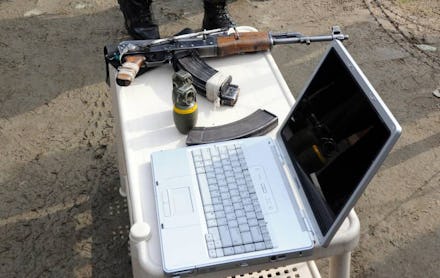Something Terrifying Has Been Discovered on an Islamic State Laptop

The news: Extremists flying the banner of the Islamic State have some serious hardware, ranging from captured Iraqi munitions to armored Humvees originally purchased by the United States. But one item recovered from an IS safehouse by moderate rebels contains instructions to create biological weapons potentially as deadly as the machine guns and suicide vests in IS' conventional arsenal: the "laptop of doom."
In an exclusive, Foreign Policy's Harald Doornbos and Jenan Moussa reported that rebel commander Abu Ali recovered the laptop in the town of Idlib in northern Syria near the border with Turkey. The Dell computer had a hidden cache of 146 gigabytes of terrorist training manuals totaling around 35,347 files. Ranging from propaganda videos of Osama bin Laden to manuals on evading detection by security forces, the files comprise a treasure trove of tactics and strategies for carrying out an armed insurgency or surprise terrorist attacks.
The most troubling files the two reporters recovered were detailed instructions on how to create weaponized strains of bubonic plague. Doornbos and Moussa also found photos and documents demonstrating the laptop belonged to a Tunisian national named Muhammed S. who attended a university for chemistry and physics.
"Use small grenades with the virus, and throw them in closed areas like metros, soccer stadiums or entertainment centers," reads the how-to-guide, which also discusses how to isolate plague from infected animals. "Best to do it next to the air-conditioning. It also can be used during suicide operations."
"The advantage of biological weapons is that they do not cost a lot of money, while the human casualties can be huge."
Finally, the documents included fatwas authorizing the use of bio-weapons "... even if it kills all of them and wipes them and their descendants off the face of the Earth."
That's pretty terrifying, but it's already out there. Despite the seemingly shocking revelations, everything on the so-called "laptop of doom," is already publicly available online. A report by the Harry L. Stimson Center notes that chemical weaponry formulas have been "published and publicly available for decades," but that actually making them would require either a well-financed, centralized operation (like the Japanese doomsday cult Aum Shinrikyo, which succeeded) or a long, complicated and dangerous process of making small amounts in secret.
Terrorism expert Magnus Ranstorp told Doornbos and Moussa that the primary difficulty wouldn't be gathering the necessary pathogens, but developing a method to disperse them in a way that would infect many people at once — something he said is quite within IS' capabilities.
Easy to get, hard to make. Biological weaponry is easier to acquire, but even highly trained scientists can have difficulty isolating virulent toxins or the deadliest strains of pathogens. Dispersing it, as Ranstorp indicated, is also extremely difficult. Everything from creating an effective open-air delivery system to correctly anticipating meteorological conditions requires technical expertise as well as specialized equipment.
Aum Shinrikyo, which had access to highly-trained scientists and enough money to build a $30 million sarin-producing facility failed to create effective bioweapons. Intense effort by al-Qaida to acquire bioweapons repeatedly amounted to nothing. So while IS could succeed where others have failed, the process to create an effective biological weapon is much more complicated than taking a few samples from plague-infected cows and breeding them in petri dishes.
Some 1,500 U.S. labs regularly handle deadly pathogens, and Reuters reports that they haven't always done so responsibly. High-profile accidents like the theft of anthrax from a lab in 2001, resulting in attacks which killed 5 and infected 17, or numerous instances of deadly diseases being lost or escaping from supposedly secure facilities (which happened a shocking 269 times in 2010), demonstrate that it might be easier to simply steal the stuff rather than homebrew it.
Why you should care: The recovered laptop has some pretty scary stuff on it, but right now it's unlikely the IS can actually produce biological weapons. If it was as easy as putting some chemicals in a grenade, they'd probably be doing it already, but there's a big gap between torrenting a PDF on bubonic plague and actually releasing it on unsuspecting civilians.
But that doesn't mean IS isn't capable of funneling large amounts of money into a bio-weapons program or recruiting the experts necessary to see it through to fruition. Stateside IS affiliates or their ilk could also smuggle or outright steal pathogens from laboratories with poor security or oversight. Preventing IS from acquiring the means to do either is a serious priority deserving international effort and attention.